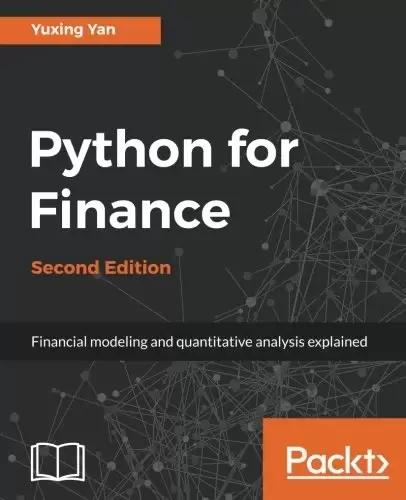
Book Description
Learn and implement various Quantitative Finance concepts using the popular Python libraries
About This Book
- Understand the fundamentals of Python data structures and work with time-series data
- Implement key concepts in quantitative finance using popular Python libraries such as NumPy, SciPy, and matplotlib
- A step-by-step tutorial packed with many Python programs that will help you learn how to apply Python to finance
Who This Book Is For
This book assumes that the readers have some basic knowledge related to Python. However, he/she has no knowledge of quantitative finance. In addition, he/she has no knowledge about financial data.
What You Will Learn
- Become acquainted with Python in the first two chapters
- Run CAPM, Fama-French 3-factor, and Fama-French-Carhart 4-factor models
- Learn how to price a call, put, and several exotic options
- Understand Monte Carlo simulation, how to write a Python program to replicate the Black-Scholes-Merton options model, and how to price a few exotic options
- Understand the concept of volatility and how to test the hypothesis that volatility changes over the years
- Understand the ARCH and GARCH processes and how to write related Python programs
In Detail
This book uses Python as its computational tool. Since Python is free, any school or organization can download and use it.
This book is organized according to various finance subjects. In other words, the first edition focuses more on Python, while the second edition is truly trying to apply Python to finance.
The book starts by explaining topics exclusively related to Python. Then we deal with critical parts of Python, explaining concepts such as time value of money stock and bond evaluations, capital asset pricing model, multi-factor models, time series analysis, portfolio theory, options and futures.
This book will help us to learn or review the basics of quantitative finance and apply Python to solve various problems, such as estimating IBM’s market risk, running a Fama-French 3-factor, 5-factor, or Fama-French-Carhart 4 factor model, estimating the VaR of a 5-stock portfolio, estimating the optimal portfolio, and constructing the efficient frontier for a 20-stock portfolio with real-world stock, and with Monte Carlo Simulation. Later, we will also learn how to replicate the famous Black-Scholes-Merton option model and how to price exotic options such as the average price call option.
Style and approach
This book takes a step-by-step approach in explaining the libraries and modules in Python, and how they can be used to implement various aspects of quantitative finance. Each concept is explained in depth and supplemented with code examples for better understanding.
Table of Contents
Chapter 1. Python Basics
Chapter 2. Introduction to Python Modules
Chapter 3. Time Value of Money
Chapter 4. Sources of Data
Chapter 5. Bond and Stock Valuation
Chapter 6. Capital Asset Pricing Model
Chapter 7. Multifactor Models and Performance Measures
Chapter 8. Time-Series Analysis
Chapter 9. Portfolio Theory
Chapter 10. Options and Futures
Chapter 11. Value at Risk
Chapter 12. Monte Carlo Simulation
Chapter 13. Credit Risk Analysis
Chapter 14. Exotic Options
Chapter 15. Volatility, Implied Volatility, ARCH, and GARCH
中文:
书名:用于金融的巨蟒,第二版
使用流行的Python库学习和实施各种量化金融概念
关于本书
- 了解Python数据结构的基础知识并使用时间序列数据
- 使用流行的Python库(如NumPy、SciPy和matplotlib)实现量化金融中的关键概念
- 包含许多Python程序的逐步教程,将帮助您学习如何将Python应用于金融
Who This Book Is For
本书假定读者已经掌握了一些与Python相关的基本知识。然而,他/她对量化金融一无所知。此外,他/她对财务数据一无所知。
What You Will Learn
- 在前两章中熟悉Python
- 运行CAPM、FAMA-FRANSE三因素模型和FAMA-FRANSE-CARHART四因素模型
- 了解如何为看涨期权、看跌期权和几种奇异期权定价
- 了解蒙特卡罗模拟、如何编写复制Black-Scholes-Merton期权模型的Python程序以及如何为一些奇异期权定价
- 理解波动率的概念,以及如何检验波动率随时间变化的假设
- 了解ARCH和GARCH进程以及如何编写相关的Python程序
详细地说
这本书使用了Python作为其计算工具。由于Python是免费的,任何学校或组织都可以下载和使用它。
这本书是按照不同的金融科目编排的。换句话说,第一版更多地关注于Python,而第二版则真正试图将Python应用到金融领域。
这本书一开始就解释了专门与Python相关的主题。然后我们讨论了Python的关键部分,解释了货币股票和债券的时间价值评估、资本资产定价模型、多因素模型、时间序列分析、投资组合理论、期权和期货等概念。
这本书将帮助我们学习或复习量化金融的基础知识,并应用Python来解决各种问题,例如估计IBM的市场风险,运行Fama-France 3因素、5因素或Fama-France-Carhart 4因素模型,估计5股票投资组合的VaR,估计最优投资组合,以及使用真实股票和蒙特卡洛模拟为20只股票投资组合构建有效边界。稍后,我们还将学习如何复制著名的Black-Scholes-Merton期权模型,以及如何为平均价格看涨期权等奇异期权定价。
Style and approach
这本书采取了一步一步的方法,解释了Python中的库和模块,以及如何使用它们来实现量化金融的各个方面。为了更好地理解,对每个概念都进行了深入的解释,并补充了代码示例。
Table of Contents
Chapter 1. Python Basics
第2章:Python模块简介
第三章:金钱的时间价值
第四章数据来源
Chapter 5. Bond and Stock Valuation
Chapter 6. Capital Asset Pricing Model
第七章多因素模型和绩效衡量
第八章时间序列分析
第九章投资组合理论
第十章期权和期货
Chapter 11. Value at Risk
Chapter 12. Monte Carlo Simulation
Chapter 13. Credit Risk Analysis
Chapter 14. Exotic Options
第15章.金融波动率、隐含波动率、ARCH和GARCH
评论前必须登录!
注册